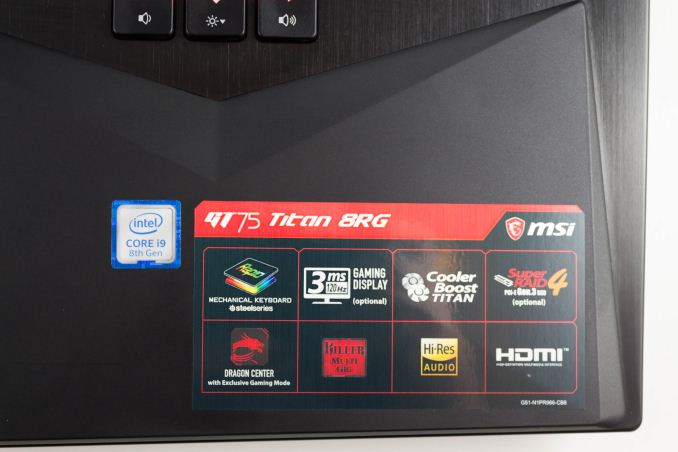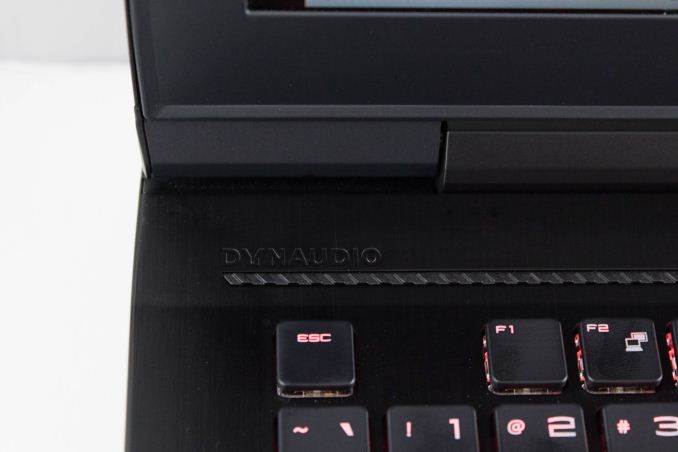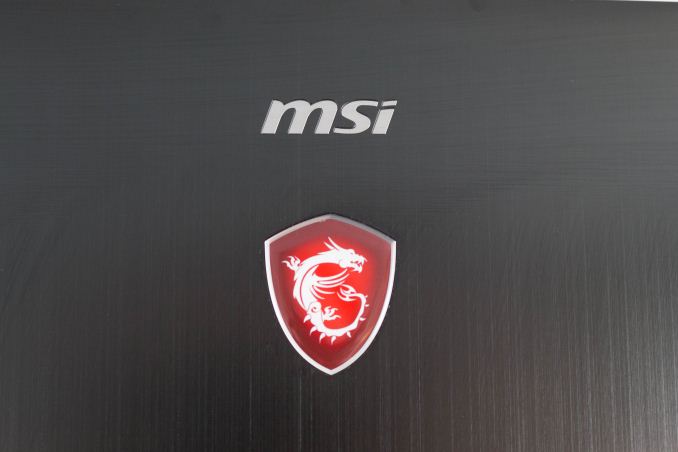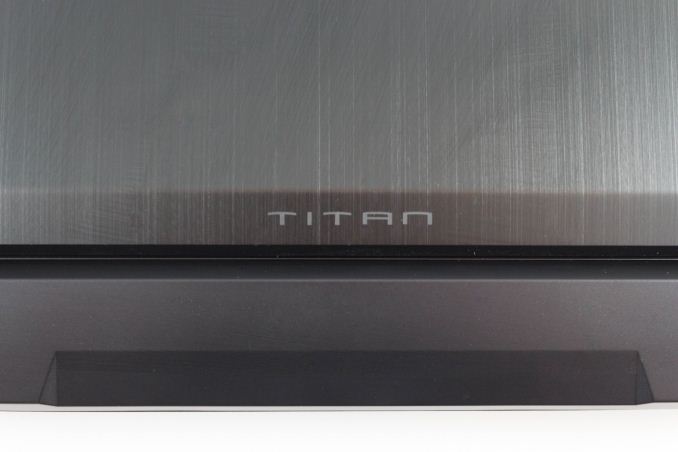The MSI GT75 Titan Laptop Review: Hex-Core DTR
by Brett Howse on September 13, 2018 9:00 AM EST- Posted in
- Laptops
- Gaming
- MSI
- Pascal
- Coffee Lake
- Coffee Lake-H
Final Words
MSI’s GT series is their top of the range, with a 15.6-inch model in the GT63, an 18.4-inch in the GT83VR, and the 17.3-inch GT75. All offer high-end laptop CPUs paired with the fastest NVIDIA GPUs available. MSI, like all gaming laptop makers, is continuously updating their products to include the latest CPUs and GPUs, and they’ve added a lot of other features to the GT75 to really make it stand out.
Design wise, there’s nothing earth-shattering here. MSI has evolved their gaming laptop styling over the years, and the GT75 Titan fits in well with the other laptops in the GT range. It looks good, and they’ve added premium materials where they count, with a nice aluminum lid, and keyboard deck. The rest of the laptop is what you’d expect out of a desktop replacement system. It’s thick, heavy, and offers plenty of air ventilation.
Arguably one of the standout features on the GT75 is the keyboard. Although the GT80 Titan first launched with a desktop class mechanical keyboard, that laptop has the keyboard mounted at the front of the system. With the GT75, MSI was able to keep the more traditional laptop design, but still implement mechanical switches. The tactile difference is immediately noticeable and welcomed. The SteelSeries keyboard also offers per-key RGB lighting and can be customized to with different lighting profiles depending on what game you are playing. The backlighting is well done, and the SteelSeries software makes it fairly easy to set it up how you like.
The move to the Intel Core i9-8950HK CPU has really moved the bar in terms of laptop CPU performance. Offering six cores and twelve threads in the same 45-Watt package as the previous quad-cores is a big win for the end user. Even if you’re only working on a single core, the 4.8 GHz maximum boost frequency is plenty to get the job done. But if you have an application or game that was limited on threads before, the 50% more threads can make a big difference.
The default display for almost all GT75 Titans is the 1920x1080 120 Hz panel. Although it’s a TN setup, the viewing angles are rated at up to 170° by MSI, and in using this system that does seem to be the case. Unlike some of the low-quality TN displays we’ve seen over the last couple of years, this one offers much better contrast, and far less shifting. The 120 Hz refresh rate makes gaming extremely smooth, and when coupled with G-SYNC, it’s a great experience. MSI does offer a 3840x2160 panel as well, which is IPS and runs at 60 Hz, but even the GTX 1080 is going to struggle with current AAA games at that resolution. Of course, at 17.3-inches, running 1920x1080 at 100% scaling is the only way to go, so you also don’t run into any odd issues, which are less of a problem today than a couple of years ago, but can still crop up from time to time.
The cooling system does a good job, and you can tweak the fan settings any way you’d like using MSI’s software. Although the Auto setting does get quite loud, it also lets the GPU run at a pretty high frequency. If you want to overclock, you can ramp the fan speed to max and get a bit more thermal room as well.
Overall, the MSI GT75 Titan is a worthy successor to the outgoing models. The GT series is not inexpensive. You can get devices that are just as fast for less money, but they are not likely to offer the same build quality, or premium features like a mechanical keyboard, and 10 Gbps network. The GT75 isn’t perfect, with minor issues like a less than amazing trackpad, but that can be overlooked when the target market is almost certainly going to be using it with a mouse on a desk. The battery life is terrible, but once again, that’s completely normal in this type of system.
Big, thick, heavy, but powerful, and refined. The GT75 Titan offers lots of configuration, plenty of features, and as much performance as we’ve ever seen in a gaming laptop.














48 Comments
View All Comments
DanNeely - Thursday, September 13, 2018 - link
At least on high end laptops like this one, I'd be interested in seeing 1440p/4k results when possible. Yes, for most titles that's still going to be an aspirational target, for another year or two; but with current high end GPUs being overkill for 1080p seeing how much farther you can push is useful; and 2080SLI (when supported) and the upcoming 7nm generation will likely be able to hit acceptable framerates in at least some titles and being able to look back against the prior generation will be beneficial.darkich - Thursday, September 13, 2018 - link
I find it beyond ridiculous that you're actually fine with a 1080p TN with this screen size and this GPU, for this price in this day and age!Can someone please explain..why would anyone need hulking 1080p POS if there are many laptops that are less than half lighter, far sleeker, cost half the price and can play EVERY game at 1080p 60fps?!?
darkich - Thursday, September 13, 2018 - link
..heck, excuse me but I have to straight up say that anyone buying this with a 1080p screen is a total idiot, sorry.Just see no point.
darkich - Thursday, September 13, 2018 - link
..oh and also, why are you ignoring the fact that not being able to play at 4K 60fps is NOT an excuse for not having a 4K screen??Is it that complicated to lower the resolution in the game settings??
Brett Howse - Thursday, September 13, 2018 - link
If you can't see the point of a 120 Hz display versus a 60 Hz display then I don't think anyone will be able to help you.darkich - Friday, September 14, 2018 - link
Fair enough.I'd still take a far more quality and detailed image on a 17" over grainy 120Hz any day
Brett Howse - Friday, September 14, 2018 - link
Well if you really are interested in this laptop but the 1920x1080 is holding you back, they do have a 3840x2160 IPS with G-Sync as well.darkich - Sunday, September 16, 2018 - link
Soo..that brings us back to my initial point, right?Why are you wasting your time on this 20 year old screen specs then?
Why aren't you reviewing the said IPS option instead ?
Benchmarking this laptop would only make sense at at least 1440p and with a screen that can actually showcase games in their full glory.
GreenReaper - Sunday, September 16, 2018 - link
They're reviewing it because people in the world *other* than you might want to buy it. If your needs lie elsewhere, that's fine. It doesn't make the product or reviews of it worthless.If colour gamut or viewing angles were the sole purchasing criteria, we'd all be using IPS screens over TN/VA. At this point in my life, and the current state of the market, I might well buy one myself. But a 120Hz screen _can_ give you a more well-defined picture of a moving object than a higher-resolution 60Hz screen, and that *may* be more important to a buyer - especially if they're trying to hit a small point on that moving object. And as mentioned above, it can avoid what some see as downsides such as desktop scaling.
There are reasons cameras have shutter speeds faster than 1/60sec as well, and one of them is because it gives you a sharper image of moving objects. Which, again, many games are full of. High-resolution textures would be wasted if they end up as a blurred mess.
There's little point in benchmarking in 1440p on an 1080p laptop because that is not how it will actually be used - and you're unlikely to swap the monitor out later (although it would be possible to plug a larger one in, I guess - in fact, that would be a *great* way to get that 4K IPS action as well).
For the inbuilt screen, antialiasing is a better way to provide image quality and use up the available video performance - and that's exactly what was tested with full-screen anti-aliasing and temporal anti-aliasing.
If I were to criticise the reviews, it would be that they seem to be an average FPS, which doesn't really cut it nowadays - I want to see 99% values, or number of frames it doesn't meet the target, because that's when you notice performance dropouts. But in many games the laptop exceeds the 120 FPS target, while in others it's still above 90 FPS. So it should deliver this particular model's key feature - high-FPS gaming.
milkod2001 - Friday, September 14, 2018 - link
For 17'' screen lappy 1080p is perfectly fine.